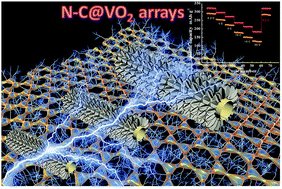Self-supported VO2 arrays decorated with N-doped carbon as an advanced cathode for lithium-ion storage†
Abstract
The development of advanced cathodes for lithium-ion batteries (LIBs) with high capacity and large energy density is of significant importance. Herein, we report a facile solvothermal-polymerization approach for the fabrication of self-supported VO2 arrays decorated with N-doped carbon (N–C@VO2). A thin N–C shell obtained from polymerized dopamine was uniformly coated on the solvothermal-synthesized VO2 skeleton, and self-supported composite arrays were formed. The lithium storage performance of the designed N–C@VO2 arrays was thoroughly studied. Due to the enhanced conductivity and more stable structure, the N–C@VO2 arrays exhibited much better reactivity and high-rate capability with a higher capacity (295 mA h g−1vs. 254 mA h g−1 at 1C) and an improved high-rate cycling life (95.3% vs. 91.5% after 500 cycles at 1C) as compared to the pure VO2 arrays. The synergistic effect between the array architecture and the N–C shell is responsible for the performance enhancement due to the accelerated reaction kinetics. Our research shows a new way to fabricate advanced high-capacity cathodes for application in electrochemical energy storage.

- This article is part of the themed collection: 2019 Journal of Materials Chemistry A HOT Papers


 Please wait while we load your content...
Please wait while we load your content...